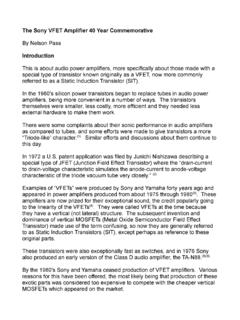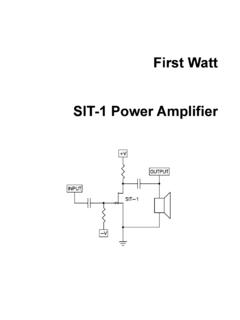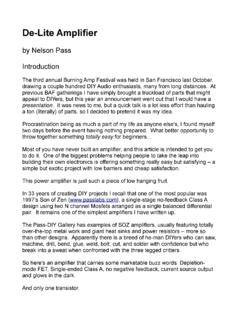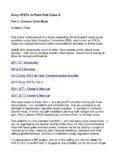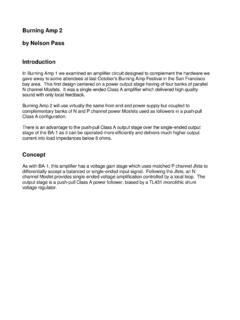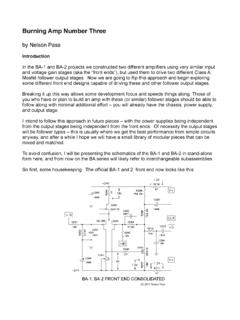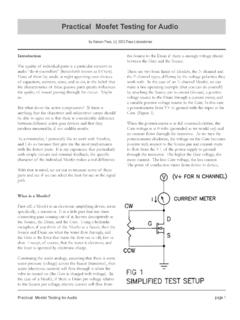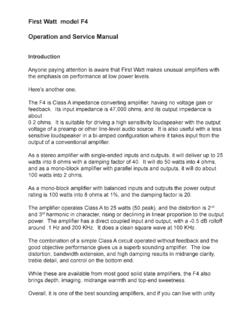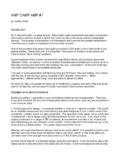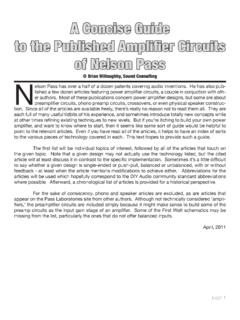Transcription of The A40 Power Amplifier - FIRST WATT
1 The A40 Power Amplifier (c) Nelson PassPass Project: A40page 1 FLATTERED BY THE opportunity to publish a project circuit, thedesigner is often beset by seemingly contradictory considerations. Onthe one hand, it is tempting to design a complex circuit as ademonstration of technical prowess; an Amplifier with large numbers ofesoteric components performing obscure functions. Such an amplifiermight be a smorgasbord of electronic technique, featuring class Aoperation, cascoding, constant current sources, current mirrors, andextra-loop error correction. It would be fascinating to build and perhapswould also sound good. On the other hand, complexity is not a good end in itself and a muchsimpler circuit would suit the needs of the amateur more ideally for lowcost, high reliability, and easy construction. Simplicity can often yieldsonic benefits, inasmuch as the fewer the number of components in asignal path, the simpler the open loop transfer curve of the Amplifier .
2 The importance of a simple transfer curve accounts partially for the highquality of sound in many tube type devices. Their simple circuitryassures a higher concentration of low order distortions, 2nd and 3rdharmonics and 1st and 2nd order intermodulations, giving them apleasant musical sound even at relatively high distortion levels. Bycontrast, the higher order distortions to be found in many poorly biasedsolid state amplifiers are less musical and thus more detectable. This effect is similar to one's ability to detect a scraping voice coil on awoofer more easily than a much higher percentage of 2nd harmonic inthe woofer. While this is partly due to the unmusical nature of theseovertones, it is also due to a fault in the measurement technique whichassumes that our ears are average responding, like the meter on thedistortion analyzer. A good example is crossover notch {the Amplifier 's equivalent of ascraping voice coil}, which is a spike of distortion occuring when thetransistors are switching the signal from the positive set to the negativeset and back again.
3 Because it only occupies a brief percentage of theoperating cycle, crossover notch distortion can occur in very high peakswhich then are averaged down to a much lower figure, giving amisleading impression of the audibility. Does the ear respond to such brief distortions? I don't know, but it is truethat amplifiers with nearly identical "standard" specifications can sounddifferent and it seems that low versus high order harmonics andintermodulation are one common key to the sonic disparity. Fewer elements in series with the signal path also result in widerbandwidth and greater stability, as there are fewer contributions to thehigh frequency rolloff of the circuit. PERFORMANCE VS. PARTS Given then that the circuit should be simple, we must find a way toachieve the exceptional performance as advertised. While we wantsimple distortion types, we also want a lot less of them, which brings usto the question: what techniques will extract maximum performance froma few parts?
4 In this case I have chosen two very effective approaches:constant current sourcing and class A operation which are combined ina deceptively simple 40 Watt per channel Amplifier . Constant current sourcing is a technique used to achieve high gain andlinearity by biasing transistors heavily without loading down the gain asa resistor current source would. A constant current source delivers aspecified value of DC current regardless of the fluctuations of the powersupply or the voltage swing of the Amplifier , resulting in less distortionand noise. Constant current sources may be formed in a number of ways, one ofthe most popular being the circuit for where the forward voltagedrops of the PN junctions is used as a reference to drive about .7 Voltsacross a resistor. This voltage across the resistor causes a constantcurrent to flow through the collector/emitter path of the transistor whichis independent of the voltage at the collector between saturation andbreakdown.
5 Of particular value in linear circuits, constant current sourcing sets upconditions where the device's operation moves it about its operatingpoint by only a small percentage of its capability. WHY CLASS A? Class A operation is integral to the performance in this case, and it isworthwhile to explore why. The primary virtue of class A lies in thesmooth characteristics of its operating parameters. The gain transistorsare operated in their linear region only, where the distortions are limitedto smooth, simple forms, unlike the abrupt distortions created when thetransistors in class B output stages switch on and off. In class A, the transistors are always on, eliminating the turn-on/turn- offdelays which characterize the crossover of class B and even ABamplifiers. The distortion is inherently lower without the need forcleaning up via feedback, thus class A lends itself well to low distortionperformance in a simple circuit with low open loop gain.
6 Fig. 2 shows thetransfer curves for a push-pull emitter follower output stage operated inclass A, B, and AB modes where the crossover distortion is apparent inthe discontinuity of the curve. In class AB, this effect is alleviated by asmall bias current, and then is eliminated in class A where the biascurrent is high. Fig. 3 shows the open loop output impedance of these stages where theclass B Amplifier is seen to rise abruptly at the discontinuity, whereas theclass AB actually drops at the point where both halves conduct class AB Amplifier can be said to run in class A over this smallregion and will exhibit class A performance at small current levels. Theclass A curve can be observed to be the smoothest of the three in aneffect which can be looked upon as the damping factor of the amplifiermultiplied by the amount of feedback employed. Naturally, this kind of performance has a price tag, and with class Aoperation, the low efficiency causes considerable energy loss.
7 Class Apower amplifiers require large Power supplies to handle this energy, butthe task is not as enormous as might be imagined. BEATING THE HEAT Class A amplifiers have different efficiency factors depending upon thedesign. The least efficient is the circuit of Fig. 4a, where the transistor isbiased by a resistor and whose AC output Power to the load is less than20 per cent of its idling dissipation. Fig. 4b shows the same configurationwhere a constant current source replaces the resistor, improving thelinearity and efficiency of the circuit. The value of the constant currentsource must be equal to or greater than the maximum output an 80W peak (40W, rms) into 8 Ohms, therefore, the current mustbe at least , which practically speaking means a worst casedissipation of 200W per channel in the idling output stage. Push-pull circuitry more or less doubles the efficiency of a class A outputstage (Fig. 4c) because unlike the constant current sourced design, itsidle current need be only one half the peak output current, or in theexample, for an idling dissipation of about 100W for a 40W Amplifier .
8 Pass Project: A40page 2At these Power levels, we will expect some degree of heat and will needto figure out the amount of cooling required. If we assume a 25 temperature, for each channel we will require a heat sink with Celsius per Watt thermal characteristic. This can easily be madefrom two .50 sinks or four 1 C/W sinks, remembering that airshould flow vertically along the fins on the sink and that some free spacemust be available on all sides of the heat sink, especially top andbottom. With this much sinking, the 100W idling dissipation will raise thesink temperature at 25 C above ambient for a temperature of 50 C. This is easily handled by the four output transistors whose cumulativedissipating capabilities are 600 Watts at this temperature. The 6:1 safetymargin here may cause some readers to wonder if I wear both a belt andsuspenders, but in my experience, textbook safe operating areas aresomewhat optimistic.
9 In real life circuits with a 2:1 safety margingenerally blow up. HEAT AND ECOLOGYC ontrary to popular belief, class A output stages are not necessarilysubject to thermal runaway. Whereas class AB Amplifier designers ofteninvest in thermal compensation to correct the delicate bias voltage, classA output stages use a gross bias current without much need for smalladjustment. The high bias currents develop significant voltages acrossthe transistors' emitter resistors, reducing the temperature dependenceof the bias. In addition, this Amplifier incorporates an interesting biascircuit which senses the idling current of a class A output stage whileignoring the AC signal and maintains a constant bias without need foradjustment. One nice thing about hefty output stages as found in class A operationis that often no protection circuitry is required beyond a fuse because ofthe excellent thermal capability of the bank of transistors.
10 This samecapability yields better performance into demanding loads and holds thetransistor chips at a more constant temperature than the flimsier outputstages found in class AB amplifiers. Nevertheless, I must admit that class A operation consumes energywhich is converted to the heat emitted by the Amplifier . While itsconsumption is about on a par with a large color television, theecologically oriented audiophile may wish to operate his class Aamplifier only during the winter, when he would otherwise be using hisheater, and revert to a class AB design Amplifier during the summer. DESIGN ANALYSIS The conceptual schematic for the Amplifier is given in fig. 5, where youcan see the rather conventional NPN differential front end which drivesa PNP voltage gain transistor. Both parts of the circuit are biased withthe constant current sources as shown, and the signal from the collectorof the PNP is followed by the Darlington class A output stage whose idlecurrent is controlled by the bias circuit.

